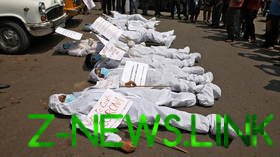
Christmas Day brought with it the ghost of the Empire in the form of one Jaswant Singh Chail, 19, who allegedly used a rope ladder to breach the spiked fence surrounding the royal residence of Windsor Castle. His mission? To kill the Queen. Chail, who was apprehended on the castle grounds shortly after setting out on his grisly quest – with a crossbow, no less – does not appear to have been in his right mind when he did so.
I say this as the Snapchat video uploaded 24 minutes before the arrest shows a man – believed to be Chail – not quite in his senses. He was using a distorted voice, dressed up in peculiar black stormtrooper garb, and referring to himself in the third person, a name closely connected to ‘Star Wars’ franchise villain Darth Vader.

While the police sift through Chail’s life and his political views, one thing seems to be clear – his motive. And that motive was to punish Queen Elizabeth for being the ostensible cause or royal representative of the Jallianwala Bagh massacre in Amritsar, India on April 13, 1919. For the uninitiated, the massacre was a brutal, blood-soaked attack by British colonial forces on defenceless men, women, and children that resulted in at least 379 deaths and 1,200 injured on that hot afternoon in the Punjab. I say at least because the British were not keen on body counts and many more succumbed to their injuries after fleeing the grounds after the gunfire subsided, too fearful to seek hospital assistance as they would no doubt be captured and seen as abetting crimes against the Empire.
Revenge was the reason for this attack but the reasons for it run deeper. And it is now clear to this author that it was indeed this very Jaswant Singh Chail who informed me two years ago – on the centenary of the Jallianwala Bagh massacre – that he held a grudge against the royals, particularly Prince Philip (who died in April this year).
I had just released a book commemorating the 1919 massacre entitled ‘Garden of Bullets: Massacre at Jallianwala Bagh’. I was born in India, so I wasn’t afraid to wear an unashamed nationalist heart on my sleeve even though I wrote the book in as fair minded and objective a stance as possible.
Nonetheless, there were chapters and prose that were clearly tied towards the narrative that grievous wrongs had been committed against Indians, and Sikhs in particular given the proximity of the Jallianwala Bagh to the holy Golden Temple, and that retribution was not an unfamiliar feeling in the hearts and minds of many aggrieved Indians who remember the time all too well.
Many peaceful protests and movements were catalysed by the massacre and motivated to take further action – not least of all Mahatma Gandhi’s campaign of civil disobedience – but others took the massacre far more personally.

One of those was Udham Singh, who waited for over twenty years to exact his revenge in March 1940 in London, executing the Lt Governor of Punjab at the time, Sir Michael O’Dwyer. O’Dwyer had given the okay to the massacre itself after the fact, essentially absolving the chief perpetrator in charge, Brigadier-General Reginald Dyer. Believing that the peaceful gathering in the Jallianwala Bagh was nothing less than a call to insurrection against the Empire, Dyer felt all his warnings to the Punjab population were not being taken seriously and decided to exact a fitting response. Rather than issue a warning shot to the protestors to leave the grounds, he immediately ordered the troops to fire until their ammunition was exhausted. Even though it was clear that protestors were outgunned, outnumbered and running for their lives, he ordered his troops to shoot. For, on this afternoon, the Empire had to proclaim its strength and purpose in his eyes.
That’s where Queen Elizabeth comes in. You might wonder how, given that she hadn’t even been born when the gunfire ceased that bloodsoaked spring in 1919. The connection, and one that Chail mentioned to me after providing feedback on my book and after having seen me discuss the massacre at a panel discussion, was that she represented an orthodoxy that felt that it was above a formal apology for the massacre, an orthodoxy that saw the evils of the Empire as part of a bygone age and that people acted differently as it was a ‘different time’.
Her late husband, Prince Philip, clearly did not ascribe to this view and this particularly irked Chail. For one, Philip served in the Navy with Brigadier Dyer’s son, Ivon, and it was there it was alleged by Philip that Ivon sprinkled doubt on the death count, that in his view the entire affair had been overblown and that the amplification of the casualty numbers were simply grist for Gandhi’s mill. The Duke of Edinburgh apparently took this at face value and accepted it as fact.
Prince Philip strangely felt compelled to parrot this hearsay throughout his life, particularly in 1997, where, true to form, he added insult to egregious injury on a royal visit to India where he accompanied Queen Elizabeth to the Jallianwala Bagh. There, he reportedly mentioned that the body count had probably been “a bit exaggerated” and that he had it on good authority that it had been. No apology, no heartfelt admission that the massacre was unwarranted, just simply an opportunity to doubt whether there were as many dead bodies as the Indians had hitherto claimed.

India was outraged at the time, and even after Theresa May’s profession of “profound regret” on the centenary, many felt that no proper atonement had been proffered by the royal establishment. Chail told me this, mentioning that no words of regret, profound or otherwise, meant a thing when the Royals themselves had affronted the victims of the massacre at the very site where it occurred. They weren’t sorry in 1919, 1997, or even 2019, and in his twisted mind, the only way to respond to that was, apparently, to punish the archetype of the Empire itself: the Queen.
The Jallianwala Bagh massacre remains an open, festering wound in the heart of many Indians, Sikhs in particular, and by association British Indians and British Sikhs who are unimpressed by those who are determined to relegate crimes of colonialism to the past. Chail may have intimated to me that the Queen was the last vestige of royalism that remained, a crime made that much more egregious by being married to the Duke of Edinburgh, essentially standing by while he threw doubt on the entire veracity of this colonial crime – and decided that it was up to him to mete out punishment.
What it does represent is an ugly reminder that the stain of the Empire confounds, agitates, eviscerates and hurts the progeny of the Empire even today, whether born in India or not. The crimes of the Empire stay in the blood and the fibres of the mind, especially if you are still deeply connected to the country where your ancestry, culture, and religion resides and emanates from.
We must take the lessons from the past and continue to teach them and the levers of power should give them the attention and gravity they justify. Dismissing them as being of just another time when things ‘were different’ will only inspire more crossbow wielding maniacs to take revenge for the past.
The statements, views and opinions expressed in this column are solely those of the author and do not necessarily represent those of RT.
© 2021, paradox. All rights reserved.





